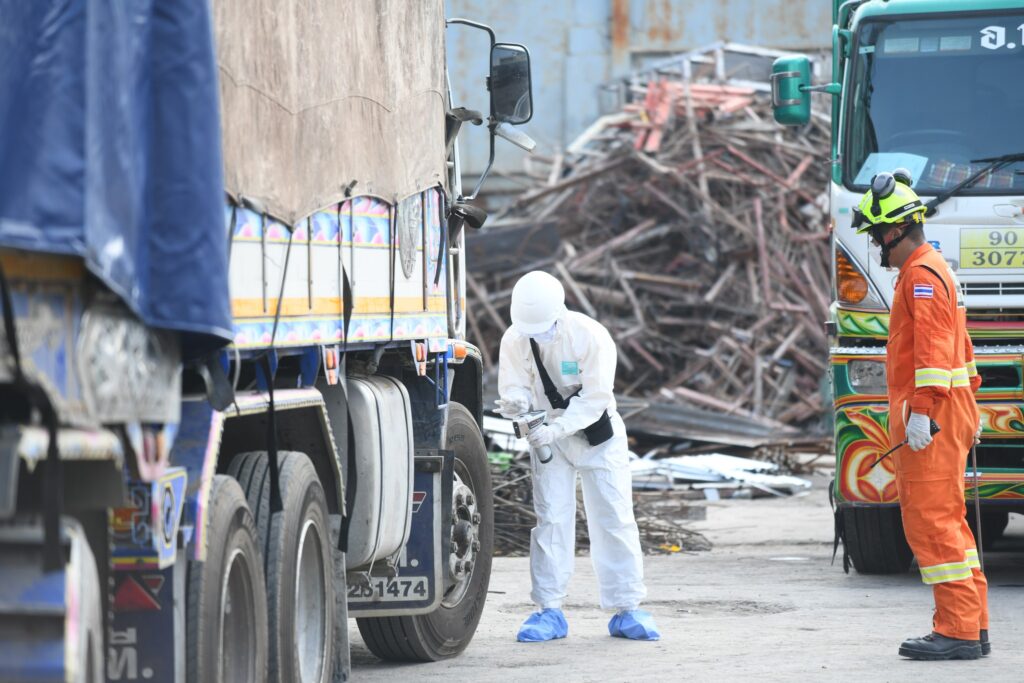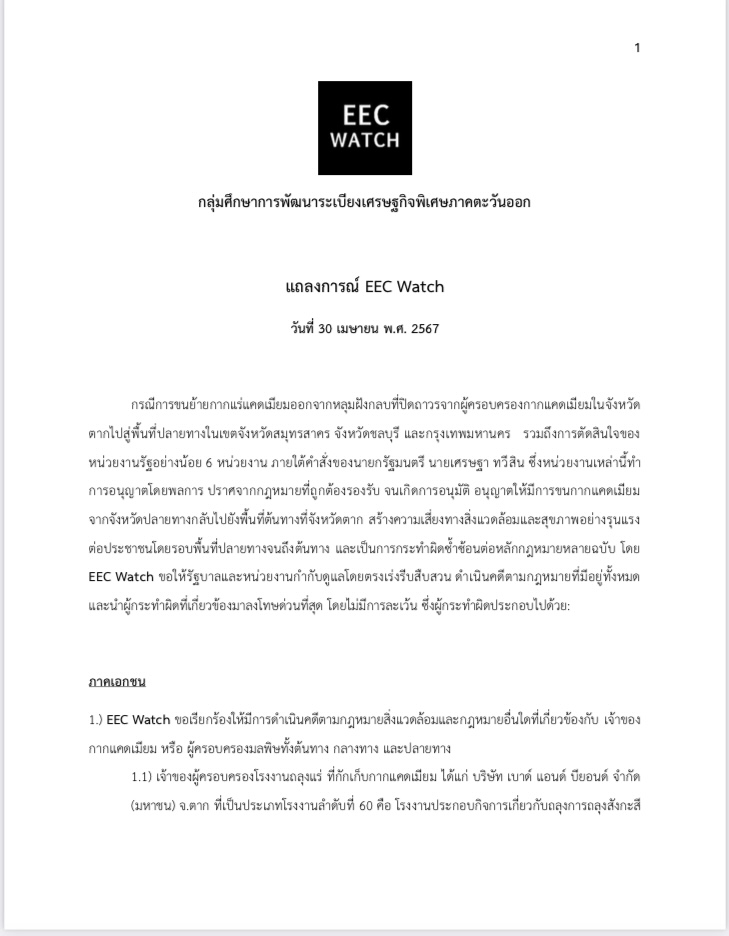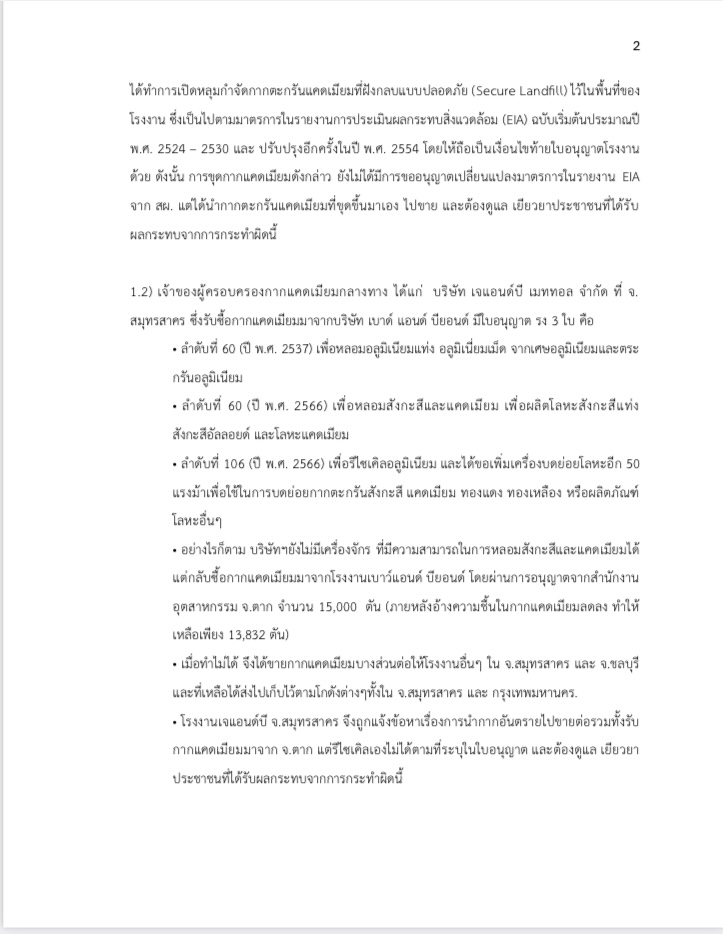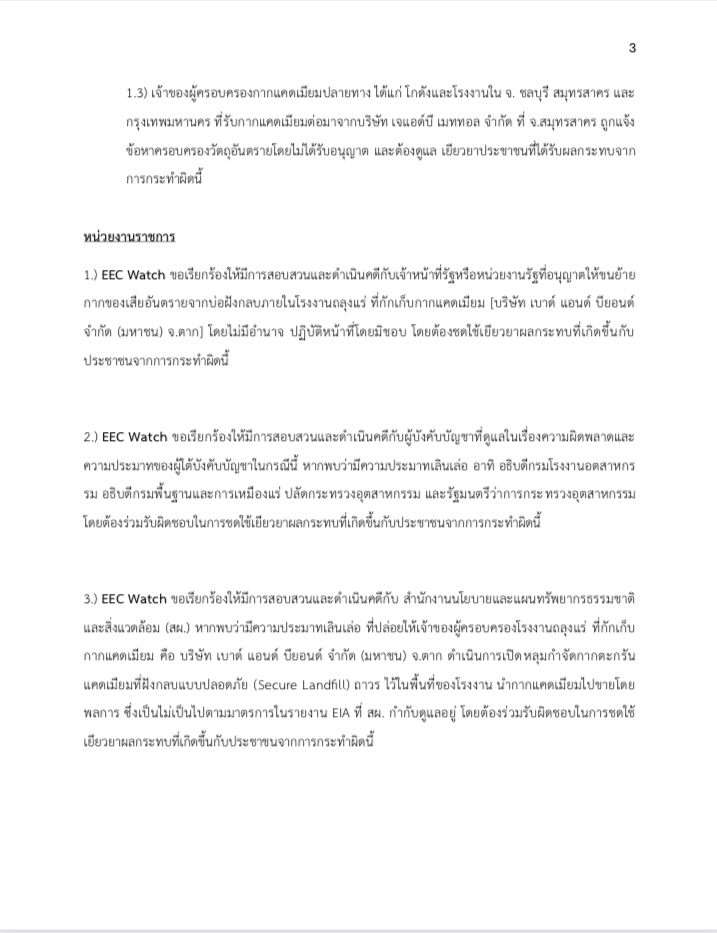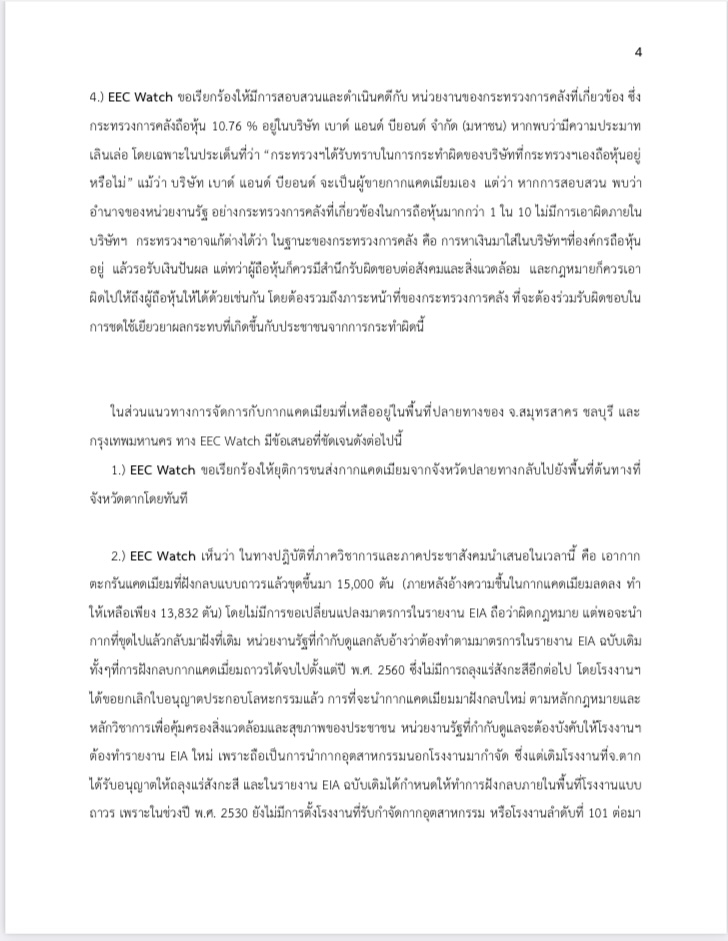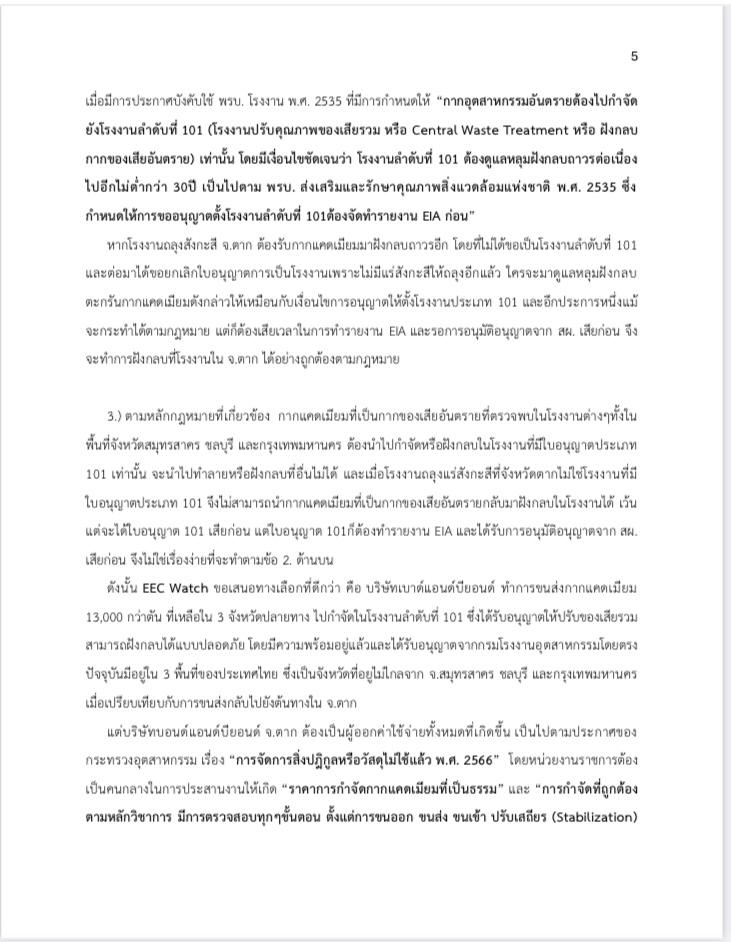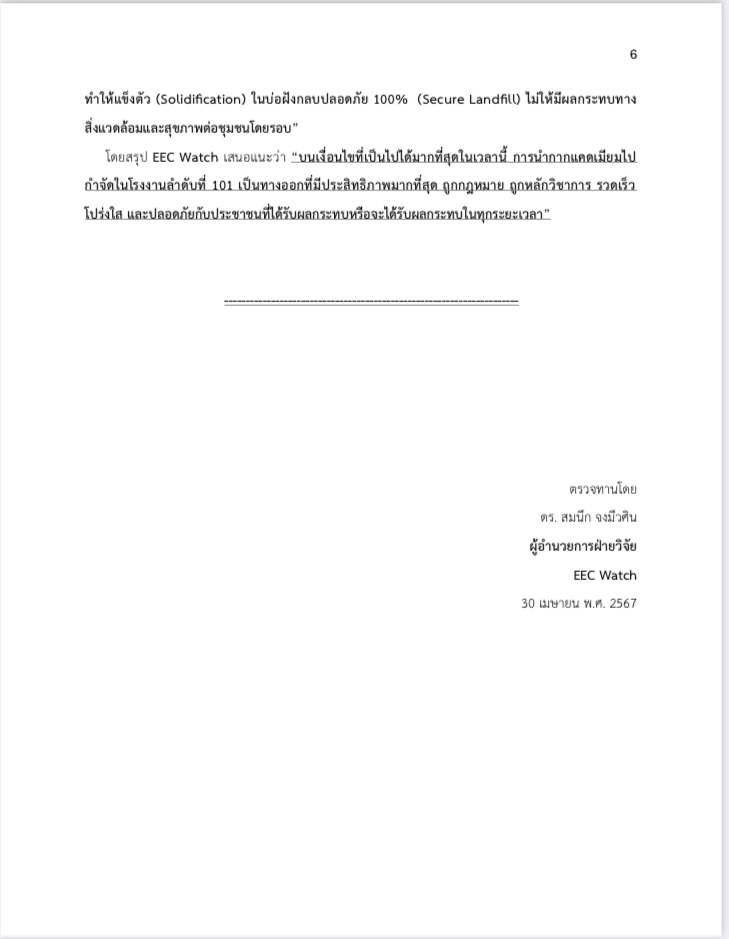The “missing” cadmium waste is set to be sent back to its original dump site in Tak province tonight onwards amid growing criticism and legal threats
Senior industry officials have revealed the plan after rehearsing the transport of some big bags of cadmium waste at an old equipment warehouse in Bang Sue area in Bangkok yesterday. According to their plan, 150 tonnes of cadmium waste in 100 big bags there and another 120 tonnes in 80 big bags from a warehouse of J and B Metal Co., Ltd. in Samut Sakhon would be the first batch to be transferred back to Tak province tonight, nearly 500 kilometres away from its scattered storage locations in Samut Sakhon and Bangkok. The next ones would be the rest stored in the warehouses and recycling plants in Samut Sakhon and Chon Buri respectively.
Altogether, it’s 12,948 tonnes of cadmium waste or 95% of the amount first transferred out of the landfills in Tak and then lost on the way from the reporting system before being retrieved from various locations near and in Bangkok; 534 tonnes in 356 big bags at a warehouse in Krathum Ban district in Samut Sakhon, 1,005 tonnes in 670 big bags at Xin Hong Cheng Intertrade (2008) in Mueang Samut Sakhon district, 717 tonnes in 478 big bags at J&B Metal plus another 6,151 tonnes in 4,100 big bags from the same factory, and last but not least, 4,391 tonnes retrieved from a Chinese recycling plant in Chon Buri’s Khlong Kiew district.
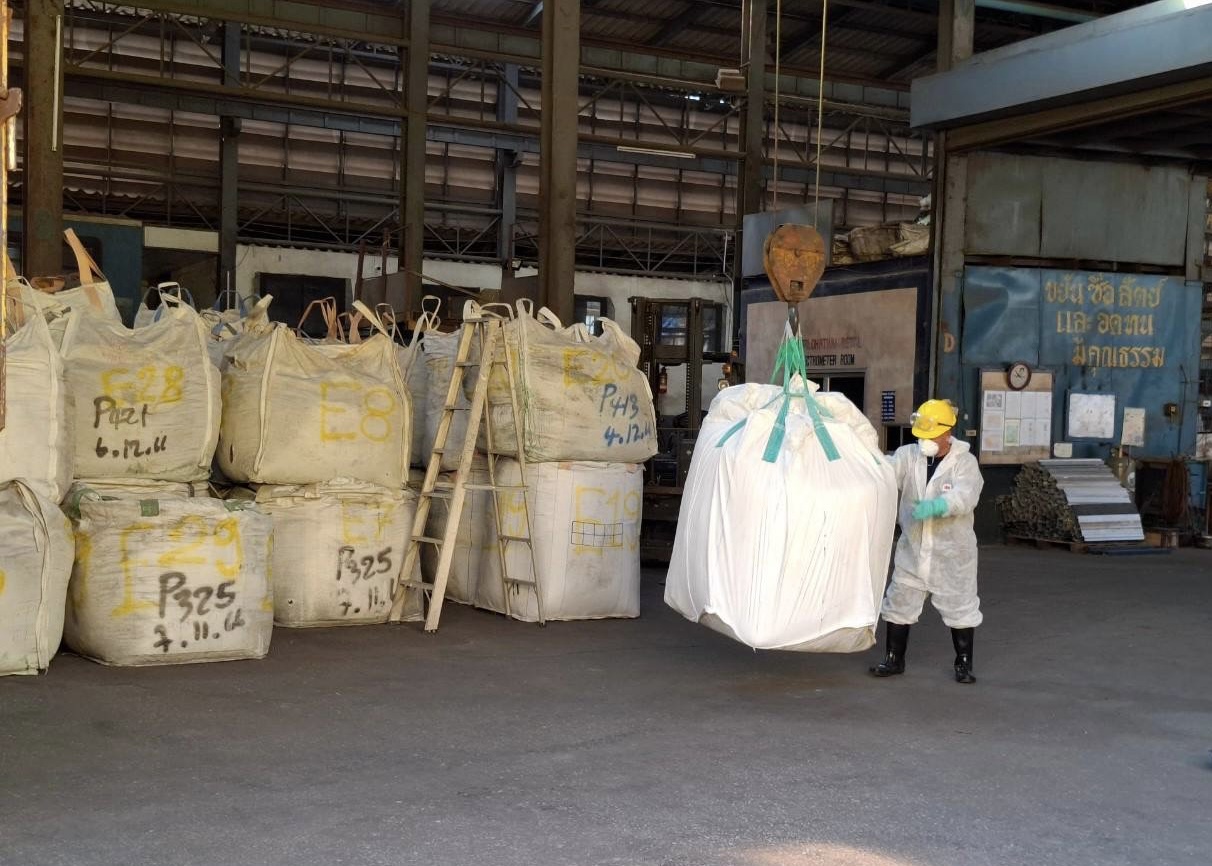
They will be moved back to the warehouses in Tak province by 30 truck trailers until June 17 before being buried down in the old landfills, which are still under improvement, according to the officials. Those compounds belong to Bound and Beyond Plc, which was a zinc extractor, which produced the cadmium waste as its by-product.
The Pollution Control Department (PCD) said the trailers will be covered by waterproof plastic sheets and they will not stop on the way unnecessarily. They will be followed via the GPS and the PCD’s Environmental Protection Units will travel with the trailers and monitor possible pollution along the way and at their destination in Tak province, the PCD’s chief, Preeyaporn Suwankes said.

Unconvincing task
Sonthi Kotchawat, the country’s noted pollution management expert and a member with expertise of the Lower House’s Standing Committee on Industry has questioned the cadmium waste retransfer operation, saying it’s too rushed.
The officials must ensure they have the risk assessment and emergency plans for possible leakage of the cadmium waste into the environment along the way and down to its destination. Mr. Sonthi said it’s too rushed to transfer the waste back while its old landfills are not ready. The factory in Tak, a zinc extractor that left cadmium as its by-product, has ceased its operation since 2017 and hardly had equipment left to do the task, compared to 101 central waste treatment plants. The reckless operation could lead to toxic contamination again, he said.
As the factory in Tak is no longer operational, who will take care of the waste after it’s transferred to the site?, he further asked.
Mr. Sonthi earlier questioned whether the operation is lawful as the factory in Tak is not a 101 central waste treatment plant either. It has not yet applied for a certification and got certified, so it should not be able to take the waste back to dump it into its landfills, he said. In the past, the factory could do so under special conditions posed as mitigation measures along with its EIA as there were no certified 101 plants introduced at that time, and if it wants to do this again, it must comply with the law concerning waste treatment now. (Read: Waste generator questioned for legality to transfer “missing” cadmium waste back to its landfills)

As examined by the residents nearby and an MP from Move Forward Party, Karit Pannaim, yesterday, the operation and the preparation at the dump site were also questioned hard by them.
Mr. Karit said the operation was too rushed and moved up from what earlier scheduled without rationales given to the public. He and the residents were informed briefly before the operation was kicked off today. They had to rush to check the dump site at the factory, he said.
Mr. Karit said he was concerned about the warehouses set to take all the transferred waste while pending the improvement of the landfills to be completed. The officials are planning to cover the ground with synthetic clay, not cement as first informing them, and the ground is not properly pressed. This preparation prompted the residents to fear leakage in the future, suggesting that the warehouses to receive the waste back are not ready as well.
“I opened up the synthetic sheets and learned about the rocky ground underneath. So, how could we lay trust in you? Everything is too rushed and not 100% ready,” said Mr. Karit, adding he also questioned the quality of the sheets but received no confirmation on the quality from the officials concerned.
At first, they told them that the waste would be stored in metal containers, which would then be moved into the warehouses, but now it’s being transfered back in the same big bags with new covers, retaining the same risk of possible leakage, he said. The residents were not confirmed either whether the cadmium waste is adequately neutralised and stabilised as first dumped into the landfills.
“Do you forget what you first promised to us; that you would let us participate in the processes? Today, it seems that the residents are being pushed out of the plan again,” said Mr. Karit.

The Lower House’s Standing Committee on Land, Natural Resources and the Environment, meanwhile, has posed legal threats against all officials concerned; from the DIW’s chief, the permanent secretary of the Industry Ministry, and the Industry Minister herself.
It said they must be held responsible for the incident and the clear-up plan as the committee has examined the case and learned there have been irregularities from the beginning, when Bound and Beyond first dug up the waste from its landfills and then put it for sale, to the end, which is the transport of the waste back to its landfills.
Earlier, the Lawyers Council of Thailand also posed a legal threat to them, saying it would set up a working group to work in this case to help those affected by the incident with legal procedures. Those possessing the waste as well as officials involved in this irregularity would be subject to lawsuits accordingly, it said at its recent press conference.
The council is particularly concerned about the health of people living close to those factories from Tak to Bangkok and has demanded blood and urine tests for them. The council stressed that the operation at the landfills must be investigated to see whether it had complied with the EIA in the first place. The council also agreed with the pollution management experts on the point that the waste generator cannot transfer the waste back to dispose of it again as it has no 101 permits.
The National Environment Board, meanwhile, has signed a new order to set up its sub-panels chaired by Governors to examine hazardous waste management facilities nationwide and factories associated with them to assess potential risks of their waste disposal. They are instructed to report to the NEB within 20 days. The new order was signed on April 26, by Deputy PM and Environment Minister Gen Patcharawat Wongsuwan, NEB’s chair.
(Updated/ April 30: The statement by EEC Watch, which calls for legal action against possible wrongdoers from both private and government sectors in this case, read below.)
Indie • in-depth online news agency
to “bridge the gap” and “connect the dots” with critical and constructive minds on development and environmental policies in Thailand and the Mekong region; to deliver meaningful messages and create the big picture critical to public understanding and decision-making, thus truly being the public’s critical voice

